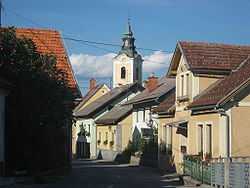Semič
| Semič | |
|---|---|
| Settlement | |
 | |
_location_map.svg.png) Semič | |
| Coordinates: 45°39′16.56″N 15°10′42.01″E / 45.6546000°N 15.1783361°ECoordinates: 45°39′16.56″N 15°10′42.01″E / 45.6546000°N 15.1783361°E | |
| Country |
|
| Traditional region | Lower Carniola |
| Statistical region | Southeast Slovenia |
| Municipality | Semič |
| Area | |
| • Total | 11.47 km2 (4.43 sq mi) |
| Elevation | 318.5 m (1,044.9 ft) |
| Population (2012)[1] | |
| • Total | 2,017 |
| • Density | 176/km2 (460/sq mi) |
| Time zone | CET (UTC+01) |
| • Summer (DST) | CEST (UTC+02) |
Semič (pronounced [ˈseːmitʃ]; German: Semitsch[2]:14) is a market settlement in Slovenia and the seat of the Municipality of Semič in the traditional region of White Carniola in southeastern Slovenia. The municipality is included in the Southeast Slovenia Statistical Region. It gets its name from Semenič Castle, which used to stand on a hill above the settlement.[3] Semič was the location of a Yugoslav Partisan base and airfield in the Second World War, from where Allied airmen and escaped and freed prisoners of war were airlifted to safety.[citation needed]
The parish church in the settlement is dedicated to Saint Stephen and belongs to the Roman Catholic Diocese of Novo Mesto. It was first mentioned in written sources dating to 1228.[4]
Hamlets
Semič contains a large number of hamlets, some of which used to be independent settlements. These include Coklovca, Gaber pri Semiču, Gora, Kašča, Kot pri Semiču (German: Winkel),[2]:6 Krč, Mladica, Podturn, Sadinja Vas (Sadinja vas, German: Sodinsdorf[2]:6), Sela pri Semiču (German: Sela bei Heiligengeist[2]:14), Trata, Vavpča Vas (Vavpča vas, German: Amtmannsdorf[2]:14), Vrh, and Vrtača pri Semiču.
The name of the hamlet of Gaber, in the southwest part of the settlement, was changed to Gaber pri Semiču in 1953.[5]
The name of the former village of Sela pri Svetem Duhu (literally, 'Sela by the Holy Spirit') in the east-central part of settlement was changed to Sela pri Semiču (literally, 'Sela by Semič') in 1955. The name was changed on the basis of the 1948 Law on Names of Settlements and Designations of Squares, Streets, and Buildings as part of efforts by Slovenia's postwar communist government to remove religious elements from toponyms.[5][6][7] Sela pri Semiču ceased to exist as an independent settlement in 2001, when it was annexed by Semič.[8]
References
- ↑ "Semič". Place Names. Statistical Office of the Republic of Slovenia. Retrieved 8 August 2012.
- ↑ 2.0 2.1 2.2 2.3 2.4 Leksikon občin kraljestev in dežel zastopanih v državnem zboru, vol. 6: Kranjsko. 1906. Vienna: C. Kr. Dvorna in Državna Tiskarna.
- ↑ Semič municipal site
- ↑ "EŠD 2251". Registry of Immovable Cultural Heritage (in Slovene). Ministry of Culture of the Republic of Slovenia. Retrieved 4 March 2011.
- ↑ 5.0 5.1 Spremembe naselij 1948–95. 1996. Database. Ljubljana: Geografski inštitut ZRC SAZU, DZS.
- ↑ Premk, F. 2004. Slovenska versko-krščanska terminologija v zemljepisnih imenih in spremembe za čas 1921–1967/68. Besedoslovne lastnosti slovenskega jezika: slovenska zemljepisna imena. Ljubljana: Slavistično društvo Slovenije, pp. 113–132.
- ↑ Urbanc, Mimi, & Matej Gabrovec. 2005. Krajevna imena: poligon za dokazovanje moči in odraz lokalne identitete. Geografski vestnik 77(2): 25–43.
- ↑ Statistični urad Republike Slovenije: Semič (Slovene)
External links
-
 Media related to Semič at Wikimedia Commons
Media related to Semič at Wikimedia Commons - Semič at Geopedia
- Semič municipal site
